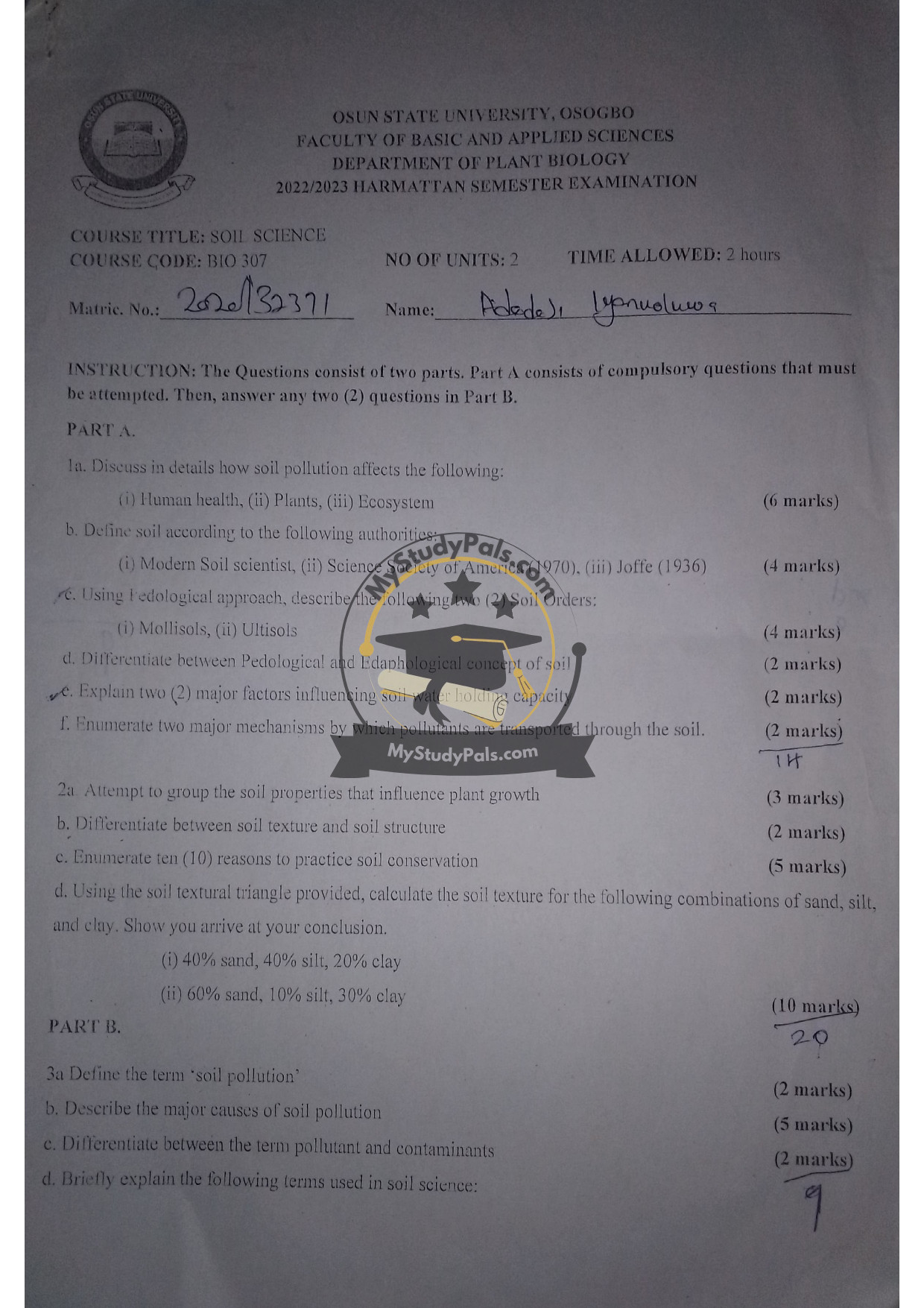ANWSER
—
Question 1 (2017/2018):
(a) What is a soil profile?
A soil profile is a vertical section of the soil that displays all of its horizons (layers) from the surface down to the parent material.
(b) Make an illustrative description of the soil profile.
A typical soil profile consists of the following horizons:
– O Horizon: Organic layer (undecomposed or partially decomposed plant material).
– A Horizon (Topsoil): Mineral layer mixed with organic matter, dark in color, rich in nutrients.
– E Horizon (Eluviation layer): Light-colored layer where leaching of minerals and organic matter occurs.
– B Horizon (Subsoil): Accumulation of clay, iron, or aluminum from above layers, less organic matter.
– C Horizon: Partially weathered parent material, little soil formation.
– R Horizon: Unweathered bedrock.
(c) Why is the study of soil profile important to soil scientists?
It helps in understanding soil formation processes, nutrient distribution, water retention, and suitability for agriculture or construction.
(d) Distinguish clearly between the following pairs of soil concepts:
(i) Pedon and soil individual:
– Pedon: Smallest 3D unit of soil that represents the entire soil profile.
– Soil individual: A collection of similar pedons classified as a single soil type.
(ii) Soil and ‘non-soil’ components of the soil profile:
– Soil: Includes mineral and organic matter supporting plant growth.
– Non-soil: Rocks, water, or air within the profile that do not contribute to soil functions.
(iii) Topsoil and subsoil:
– Topsoil (A Horizon): Rich in organic matter and nutrients.
– Subsoil (B Horizon): Contains accumulated minerals but less organic matter.
(iv) Mineral soil and organic soil:
– Mineral soil: Dominated by mineral particles (sand, silt, clay).
– Organic soil: Contains >20% organic matter (e.g., peat).
—
Question 2 (2017/2018):
(a) What is meant by soil horizon?
A soil horizon is a distinct layer of soil parallel to the surface, differing in physical, chemical, and biological properties from adjacent layers.
(b) Discuss the processes involved in the development of the soil horizon.
– Additions: Inputs like organic matter or dust.
– Losses: Leaching of minerals or erosion.
– Translocations: Movement of materials (e.g., clay to B horizon).
– Transformations: Weathering of minerals or decomposition of organic matter.
—
Question 1 (2019/2020):
(a) Why is the study of soil regarded as a broad discipline of science?
It integrates geology, biology, chemistry, and physics to understand soil formation, classification, and management.
(b) Briefly explain five reasons for studying soils.
1. Agriculture: Determines crop suitability and productivity.
2. Ecology: Supports biodiversity and nutrient cycling.
3. Construction: Influences foundation stability.
4. Water Management: Affects filtration and groundwater recharge.
5. Climate Change: Soils store carbon and regulate greenhouse gases.
(c) Two basic approaches adopted by pedologists to study soils:
1. Pedological: Focuses on soil formation, classification, and mapping.
2. Edaphological: Emphasizes soil’s relationship to plant growth and agriculture.
(d) Write short notes on the following:
– Solum: A horizon + B horizon (zone of active soil formation).
– Pedon: Smallest 3D soil unit representing a soil type.
– Topsoil: Nutrient-rich surface layer (A horizon).
– Subsoil: Mineral-rich layer below topsoil (B horizon).
– Mineral soil: Dominated by inorganic particles.
– Organic soil: High organic content (e.g., peat).
—
Question 3 (2019/2020):
(a)(i) What is a soil profile?
A vertical section showing soil horizons from surface to bedrock.
(ii) Description of a generalized soil profile:
(See 2017/2018 Q1(b) for illustration.)
(b) Importance of studying soil profile:
1. Identifies soil fertility and limitations.
2. Guides land use planning.
3. Helps in environmental conservation.
—
Question 4 (2019/2020):
(a) What is meant by soil horizon?
A distinct soil layer with unique properties.
(b) Characteristics of horizons:
– O: Organic debris.
– A: Dark, nutrient-rich.
– E: Leached minerals.
– B: Accumulated clay/oxides.
– C: Weathered parent material.
– R: Bedrock.
(c) Processes promoting horizon development:
– Weathering, leaching, accumulation, and bioturbation.
—
Question 1 (2022/2023):
(a) Effects of soil pollution:
– Human health: Toxins cause diseases (e.g., cancer).
– Plants: Reduced growth, nutrient uptake.
– Ecosystem: Biodiversity loss, water contamination.
(b) Definitions of soil:
1. Modern Soil Scientist: Dynamic natural body supporting life.
2. SSSA (1970): Medium for plant growth, with layers formed by weathering.
3. Joffe (1936): Natural body synthesized from parent material.
(c) Soil Orders:
– Mollisols: Fertile, dark (grassland soils).
– Ultisols: Weathered, acidic (tropical/subtropical).
(d) Pedological vs. Edaphological:
– Pedology: Soil formation/classification.
– Edaphology: Soil-plant relationships.
(e) Factors influencing water holding capacity:
1. Texture: Clay retains more water than sand.
2. Organic Matter: Increases retention.
(f) Pollutant transport mechanisms:
1. Leaching (water movement).
2. Adsorption (binding to soil particles).
—
Question 2 (2022/2023):
(a) Soil properties influencing plant growth:
– Physical (texture, structure), Chemical (pH, nutrients), Biological (microbes).
(b) Soil texture vs. structure:
– Texture: Proportion of sand, silt, clay.
– Structure: Arrangement of particles into aggregates.
(c) Reasons for soil conservation:
1. Prevents erosion.
2. Maintains fertility.
3. Protects water quality.
4. Supports biodiversity.
5. Mitigates climate change.
(d) Soil texture calculations:
(i) 40% sand, 40% silt, 20% clay → Loam
(ii) 60% sand, 10% silt, 30% clay → Sandy clay loam
—





